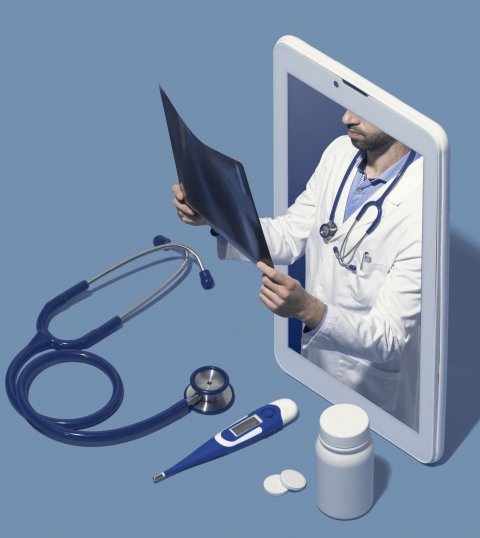
Image sources: HIMSS/University of Texas at Austin/Crossover Health
Article • Hybrid care models
Telemedicine or in-person care: Why not both?
Will telehealth replace traditional in-person healthcare? Healthcare and digital health professionals around the world have moved beyond this question. Telehealth scenarios are here to stay, and so is traditional healthcare. The relevant question is how both can be combined for optimum results. This is the focus of hybrid care models.
Report: Dr Christina Czeschik
Jonah Comstock of HIMSS recently presented a webinar on opportunities and challenges in hybrid care, with Kristi Henderson, CEO of MedExpress at Optum, and Scott Shreeve, MD, CEO of Crossover Health.
Telehealth on the rise

Image source: Shutterstock/Stokkete
The pandemic has accelerated the acceptance of telehealth services, such as video consultations, around the world. In the USA, 11 more telehealth services have been added to the list of Medicare-reimbursable items. In Germany, the recent DVMPG legislation will soon permit doctors to treat up to 30% of their cases via video call (formerly 20%) and see patients via video call outside office hours (medical after-hours services), and also allows other independent medical professionals, such as midwives, to offer video consultations.
Telehealth services address a wide range of current challenges to patients and medical professionals: They decrease infection risk, lower barriers and increase accessibility to healthcare for patients with limited mobility or, in infrastructurally underdeveloped regions, provide new opportunities for healthcare providers to work location-independently and with a family-friendly schedule, and increase efficiency all over the healthcare system. However, in-person visits cannot be replaced by telehealth services wholesale, regardless of context. Knowing which indications are most suitable to telehealth vs. traditional consultation is key to maintaining patient safety and satisfaction.
Recommended article

Article • Video consultation on the rise
“A patient’s home has to become a mobile diagnostic centre”
There are many reasons why for some patients a visit to the doctor’s office is difficult or well-nigh impossible – limited mobility after surgery, old age, or a handicap. For others, particularly in rural areas, the doctor is often far away and/or difficult to reach due to poor public transport. In times of corona, another important issue emerged: infection protection.
From emergency care to mental health
A recent study by US-based telemedicine provider Amwell revealed that, in the future, 76% of patients expected to use telehealth services at the same level or more frequently than before the pandemic and 92% of physicians were planning to provide them. Telehealth adoption varies with subspecialty. Psychiatrists are among the vanguards of digital services while emergency physicians are near the lower end of the spectrum of telehealth adoption.
Physicians already have thoughts about the best ways to combine telehealth and traditional consultation in a hybrid model: They were most comfortable to provide prescription renewals and regular chronic care check-ins via video call (94% and 93%), but were more conservative about urgent care consultations and initial meetings with patients.
In the HIMSS webinar, Henderson and Shreeve disagree. ‘Digital first, strategically in person’. Brick-and-mortar medical centres might go from having an exploratory to having a confirmatory focus. If all patients are seen digitally first, in-person facilities do not need to be prepared for all eventualities.
Both the Amwell research and the HIMSS experts suggests that, in the future, hybrid care models will be pervasive and increasingly seamless throughout the continuum of care. Telehealth will not be confined to certain siloed indications or subspecialties. Some services have to remain in-person, for example the taking of blood and other samples, vaccinations, surgical procedures. Others will be digitised almost regardless of the medical specialty – such as monitoring of vital parameters and medical-administrative work like the renewal of prescriptions. Hybrid healthcare of the future may come to resemble today’s banking landscape between online banking, ATMs and office visits.
Challenges: reimbursement and digital skills
Developing adequate workflows comes with some challenges. Firstly, reimbursement regulations are often lagging behind technological opportunities. Only the in-person components of hybrid care are reimbursed, not the digital ones. If physicians and institutions want to establish new hybrid care workflows, they often have to rely on patients who are willing to pay out of pocket, find funding for pilot projects, or forgo reimbursement for months or even years.
Secondly, healthcare professionals are still in the process of acquiring the necessary digital expertise. That not only includes skills as a user of digital tools but also and, more importantly, knowledge about how to choose the right tool for the right indication, meet patient expectations and work in an economically viable way, all at the same time. For example, which kinds of patients are more likely to require in-person visits, even if at first they ask for a video consultation? How to reply to patients who request that their wearable device data is used for remote monitoring or diagnosis?
Fortunately, the time in which the individual physician or institution had to carry the burden of making all these decisions is coming to an end. Increasingly, pilot projects and regular hybrid care are evaluated scientifically, providing more and more evidence about the optimal ways of combining telehealth with in-person healthcare.
19.08.2021











